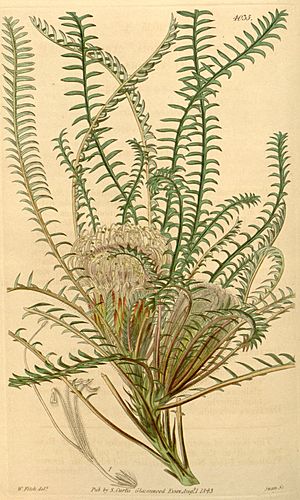Banksia arctotidis facts for kids
Quick facts for kids Banksia arctotidis |
|
|---|---|
 |
|
| Illustration from Curtis's Botanical Magazine | |
| Scientific classification | |
| Genus: |
Banksia
|
| Species: |
arctotidis
|
| Synonyms | |
|
|
Banksia arctotidis is a special kind of low-growing shrub. It is found only in the southwest part of Western Australia. This plant has unique leaves that are deeply divided. It also has creamy-colored flowers and fuzzy, egg-shaped fruits.
Contents
What Does It Look Like?
Banksia arctotidis is a shrub that grows close to the ground. It usually reaches about 0.5 to 1 meter (about 1.5 to 3 feet) tall. It can spread out to about 0.7 meters (about 2.3 feet) wide. It has a short stem that grows underground.
Its leaves are long and narrow, about 80 to 150 millimeters (3 to 6 inches) long and 5 to 8 millimeters (about 0.2 to 0.3 inches) wide. The leaves are deeply divided all the way to the middle vein. Each side of a leaf has between 25 and 45 sharp, pointed parts.
The flowers grow in spikes. These spikes are surrounded by hairy, thread-like parts called bracts. Each spike has about 75 to 100 individual flowers. The main part of the flower, called the perianth, is about 26 to 31 millimeters (about 1 to 1.2 inches) long. It is usually yellow-cream or yellowish-brown.
This plant flowers between September and October. After flowering, it produces a fruit called a follicle. This fruit is partly hairy and egg-shaped, about 10 to 14 millimeters (about 0.4 to 0.5 inches) long.
How It Got Its Name
This type of banksia was first officially described in 1830. A botanist named Robert Brown gave it the name Dryandra arctotidis. He published his description in a book called Supplementum primum Prodromi florae Novae Hollandiae.
Later, in 2007, two other scientists, Austin Mast and Kevin Thiele, changed its name to Banksia arctotidis. The second part of its name, arctotidis, comes from another plant genus called Arctotis.
Where Does It Live?
Banksia arctotidis grows in sandy soil in an area called kwongan. Kwongan is a type of shrubland found in Western Australia. You can find this plant south of Kojonup and Ongerup. It also grows through the Stirling Range National Park and near Albany.
What About Its Future?
Scientists have studied how climate change might affect this plant. They found that the area where it grows could shrink by 50% to 80% by the year 2080. This depends on how much the climate changes.
Is It Protected?
The Western Australian Government's Department of Parks and Wildlife says that Banksia arctotidis is "not threatened." This means it is not currently in danger of disappearing.
See also
 In Spanish: Dryandra arctotidis para niños
In Spanish: Dryandra arctotidis para niños

